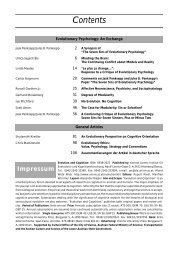Contents - Konrad Lorenz Institute
Contents - Konrad Lorenz Institute
Contents - Konrad Lorenz Institute
Create successful ePaper yourself
Turn your PDF publications into a flip-book with our unique Google optimized e-Paper software.
Steven M. Platek<br />
Figure 1: Graph depicting the additive and deception predictions from this model. If there is no actual resemblance and no one<br />
ascribes resemblance of the child to the dad then male parental investment should be low, if present. If the actual resemblance is<br />
present, but social mirror-mediated resemblance is not or actual resemblance is not present, but social mirror-mediated resemblance<br />
is present than male parental investment should be somewhere in the middle probably with much between male variance;<br />
corresponds to a coefficient of abuse score of 1. The optimal condition for male parental investment would be a situation in which<br />
both actual and social mirror-mediated resemblance is present. Females would be predicted to invest equally among all conditions<br />
since maternal resemblance in this model is not predicted to affect female behavior towards children. Filled circles represent female<br />
reactions towards children. Open circles represent male reactions under the additive model; X-filled circles represent male reactions<br />
under the deception model.<br />
netic non-relatedness, G. It is important again to<br />
keep in mind that probability of cuckoldry probably<br />
varies dramatically from 50% and is probably on the<br />
order of 1–20% (CERDA-FORES et al. 1999; SASSE,<br />
MULLER, CHAKRABORTY/OTT 1994; SYKES/IRVEN 2000).<br />
Therefore, if G is multiplied by an estimate of the<br />
cuckoldry rate (C k ) we can obtain an estimate of a<br />
male’s relative certainty of paternity as a function of<br />
an estimate of the population estimates of EPP that<br />
will be referred to as C:<br />
Therefore, G · C k = C (2)<br />
The model equation for paternal investment<br />
(PatI) can be reduced to:<br />
PatI = P/C (3)<br />
The equation might be viewed as a coefficient of<br />
paternal investment, given that as paternal certainty<br />
decreases as a function of decreased perceived or actual<br />
paternal resemblance, the likelihood that the<br />
male would be motivated to engage in offspring<br />
abuse would be expected to increase and investment<br />
would be expected to decrease. Furthermore,<br />
holding P constant and changing the relative rate of<br />
EPP will affect male investment in a manner consistent<br />
with contemporary evolutionary meta-theory.<br />
P is the product of P rt and P rs , which are proportions,<br />
and thus must be less than 1, with 1 being representative<br />
of the highest degree of actual paternal resemblance<br />
and the highest degree of social affirmation<br />
of resemblance (both abstract and difficult to measure).<br />
If we substitute modern estimates of EPP<br />
(range 1–20%), we find that an optimal paternal investment<br />
score (P rt = 1, P rs = 1, C k = 0.5, and<br />
G = 0.01) would equal 400 and decrease logarithmically<br />
to the lowest possible degree of paternal investment<br />
(or depending upon the interpretation paternal<br />
abuse) to 0.1 (P rt = 0.1, P rs = 0.1, C k = 0.5,<br />
G = 0.2).<br />
My colleagues and I have collected data pertaining<br />
to the paternal resemblance portion of this model.<br />
We have found that males bias their reactions to children’s<br />
faces, and hypothetically invest more in children<br />
that share more facial characteristics with them<br />
(PLATEK et al. 2002, 2003, under review; PLATEK 2002).<br />
We have also begun to test how actual or social mirror-mediated<br />
resemblance accounts for the variance<br />
in the way a male reacts towards the faces of children.<br />
The model predicts that when both actual and social<br />
mirror-mediated resemblance are present, a man’s reactions<br />
toward that child should be overwhelmingly<br />
positive, whereas when neither are present his reac-<br />
Evolution and Cognition ❘ 194 ❘ 2003, Vol. 9, No. 2








